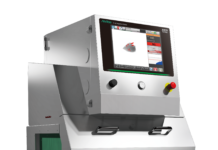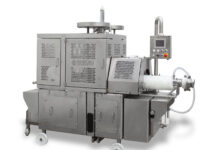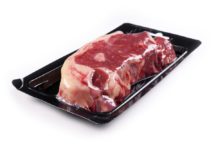 MAP consists in the replacement of atmosphere surrounding the product before sealing it in a vapor/gas barrier packaging material (1). Deteriorating processes are mainly caused by microorganisms, which find in water-rich food all the nutrients they need. Also atmosphere composition is critical for most microorganism: some necessarily require the presence of oxygen in order to survive and proliferate (yeasts, moulds, aerobic bacteria), while others are killed by oxygen (anaerobic bacteria). Taking advantage of these effects, the atmosphere inside packaging can be modified to avoid the proliferation of undesired species. MAP is also an ideal technique in addition to other mild interventions (as natural antimicrobials and/or lactic acid bacteria (2)) in the greater picture of the “hurdle technology”. Some meat characteristics are also important in determining a good MAP conservation: hygienic condition of carcass and primal cuts, water holding capacity, colour, lipid stability and even animal feed (3). Atmospheric air average composition is 78% nitrogen (N2), 20% oxygen (O2), 0.9% argon, 0.03% carbon dioxide (CO2), plus small amounts of other gases and variable amounts of water vapour (4). MAP usually mixes different amounts of N2, O2 and CO2, depending on the food and the desired effect. Other gases can be used, e.g. argon or helium (baby formula powders).
MAP consists in the replacement of atmosphere surrounding the product before sealing it in a vapor/gas barrier packaging material (1). Deteriorating processes are mainly caused by microorganisms, which find in water-rich food all the nutrients they need. Also atmosphere composition is critical for most microorganism: some necessarily require the presence of oxygen in order to survive and proliferate (yeasts, moulds, aerobic bacteria), while others are killed by oxygen (anaerobic bacteria). Taking advantage of these effects, the atmosphere inside packaging can be modified to avoid the proliferation of undesired species. MAP is also an ideal technique in addition to other mild interventions (as natural antimicrobials and/or lactic acid bacteria (2)) in the greater picture of the “hurdle technology”. Some meat characteristics are also important in determining a good MAP conservation: hygienic condition of carcass and primal cuts, water holding capacity, colour, lipid stability and even animal feed (3). Atmospheric air average composition is 78% nitrogen (N2), 20% oxygen (O2), 0.9% argon, 0.03% carbon dioxide (CO2), plus small amounts of other gases and variable amounts of water vapour (4). MAP usually mixes different amounts of N2, O2 and CO2, depending on the food and the desired effect. Other gases can be used, e.g. argon or helium (baby formula powders).
- N2: inert gas with anaerobic effect leading to inhibition of yeasts, moulds and aerobic bacteria, slowing down at the same time food oxidation; it does not influences food pH and pigments.
- O2: its presence is vital for aerobic bacteria, but at higher concentration is toxic for all microorganisms. In meat, O2 bonds to myoglobin (Mb) forming bright red MbO2. It is common to use a mixture of up to 70%-80% O2 for red meat in order to stabilize color and also inhibit all bacterial growth. However, high O2 MAP can promote oxidation of lipid (causing rancidity) and protein (causing loss of tenderness) (5). This problem can be bypassed using carbon monoxide (CO) instead of O2, but CO is a toxic gas and furthermore can mask spoilage: its use is prohibited in the European Union, but allowed in USA, and in Canada from 2010 (6).
- CO2: quantities beyond 25-30% are lethal or inhibiting for most microorganisms, especially the deteriorating and pathogen ones; at these concentrations it can also lead to color modifying (mostly due to sharp pH decrease) and to meat exudate increase due to cellular damage. High CO2 concentrations, along with N2 and no O2, are common for sliced cured meat MAP: nitrate and nitrite presence overcomes the necessity of O2 as a red color stabilizer.
MAP gases purity has to comply with food safety and food contact materials legal requirements.
MAP for meat: state of the art & new trends
 MAP is particularly successful for fresh chilled meat. If not modified atmosphere is used, meat shelf life is greatly shortened, along with a much worse visual appearance leading to poor consumers appeal. Also Vacuum Packaging (VP) can be successfully applied to meat: it consists in the complete removal of air, and it can be also considered one of MAP techniques with no air replacement. Machinery for MAP and VP are very similar or can often perform both techniques. VP is generally considered the most cost-effective packaging for meat, and can in some circumstances guarantee a longer shelf life compared to MAP, but it has some disadvantages like damages to delicate foodstuff (e.g. thin sliced meats), loss of red pigmentation, and occasionally off-odours caused by proliferation of anaerobic microbial species. Consumers needs are the driving force in MAP innovation: materials have to be vapour/gas tight but also easy to peel/open, they have to be transparent as much as possible, but printable and fog proof. A single layer or type of plastic usually does not have all needed properties for MAP applications, thus lamination, coating or coextrusion are used to create a final plastic material with desired characteristics. Heat sealing and barrier properties are often improved by application of coatings to the surface of plastic films.
MAP is particularly successful for fresh chilled meat. If not modified atmosphere is used, meat shelf life is greatly shortened, along with a much worse visual appearance leading to poor consumers appeal. Also Vacuum Packaging (VP) can be successfully applied to meat: it consists in the complete removal of air, and it can be also considered one of MAP techniques with no air replacement. Machinery for MAP and VP are very similar or can often perform both techniques. VP is generally considered the most cost-effective packaging for meat, and can in some circumstances guarantee a longer shelf life compared to MAP, but it has some disadvantages like damages to delicate foodstuff (e.g. thin sliced meats), loss of red pigmentation, and occasionally off-odours caused by proliferation of anaerobic microbial species. Consumers needs are the driving force in MAP innovation: materials have to be vapour/gas tight but also easy to peel/open, they have to be transparent as much as possible, but printable and fog proof. A single layer or type of plastic usually does not have all needed properties for MAP applications, thus lamination, coating or coextrusion are used to create a final plastic material with desired characteristics. Heat sealing and barrier properties are often improved by application of coatings to the surface of plastic films.



